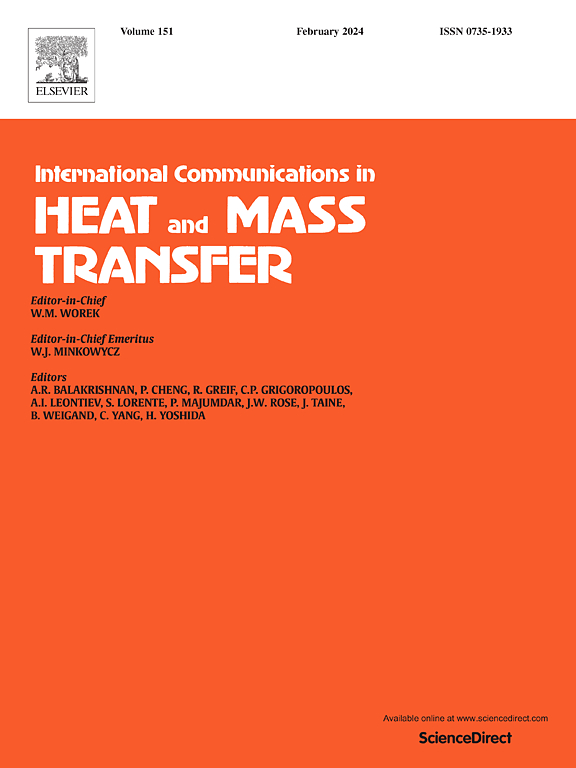Design for controlling thermal and mechanical properties of graphene oxide/silk fibroin nanocomposites: Numerical analysis and experimental study
IF 6.4
2区 工程技术
Q1 MECHANICS
International Communications in Heat and Mass Transfer
Pub Date : 2025-04-09
DOI:10.1016/j.icheatmasstransfer.2025.108945
引用次数: 0
Abstract
There is a need to develop robust and flexible thin films that can be used for efficient thermal management, especially for minimizing heat dissipation and energy loss in various applications. Here, graphene oxide (GO) and GO/silk fibroin (SF) bionanocomposite films were fabricated using a vacuum filtration method. The thermal conductivity of the bionanocomposite films was determined using scanning thermal microscopy (SThM) in the temperature contrast mode, and it was similar to thermal conductivities estimated through the inverse heat conduction problem and finite element simulation, with an error below 3 %. The local temperature and thermal conductivity of bionanocomposite films can be determined from their surface shape through SThM, and it was observed that the insulation performance of the entire film was excellent despite the small film thickness. Furthermore, through the control of the GO and SF content, the change in the area of the amorphous region, which affects the thermal conductivity and mechanical properties of the film, could be controlled. A simulation model is proposed for reliably predicting the thermal behavior of materials. GO/SF bionanocomposite films have the potential to be used as excellent insulating materials in miniaturized electronic devices.
氧化石墨烯/丝素纳米复合材料热力学性能控制设计:数值分析与实验研究
有必要开发坚固和灵活的薄膜,可用于有效的热管理,特别是在各种应用中最大限度地减少散热和能量损失。本文采用真空过滤法制备氧化石墨烯(GO)和氧化石墨烯/丝素(SF)生物纳米复合膜。利用扫描热显微镜(SThM)在温度对比模式下测定了生物纳米复合膜的热导率,其结果与通过反热传导问题和有限元模拟计算的热导率相似,误差在3%以下。通过SThM可以从表面形状确定生物纳米复合膜的局部温度和导热系数,并且可以观察到尽管膜厚很小,但整个膜的绝缘性能都很好。此外,通过控制氧化石墨烯和SF的含量,可以控制非晶区面积的变化,从而影响薄膜的导热性和力学性能。提出了一种可靠预测材料热行为的模拟模型。氧化石墨烯/硫化石墨烯生物纳米复合薄膜具有在微型化电子器件中作为优良绝缘材料的潜力。
本文章由计算机程序翻译,如有差异,请以英文原文为准。
求助全文
约1分钟内获得全文
求助全文
来源期刊
CiteScore
11.00
自引率
10.00%
发文量
648
审稿时长
32 days
期刊介绍:
International Communications in Heat and Mass Transfer serves as a world forum for the rapid dissemination of new ideas, new measurement techniques, preliminary findings of ongoing investigations, discussions, and criticisms in the field of heat and mass transfer. Two types of manuscript will be considered for publication: communications (short reports of new work or discussions of work which has already been published) and summaries (abstracts of reports, theses or manuscripts which are too long for publication in full). Together with its companion publication, International Journal of Heat and Mass Transfer, with which it shares the same Board of Editors, this journal is read by research workers and engineers throughout the world.

 求助内容:
求助内容: 应助结果提醒方式:
应助结果提醒方式:


